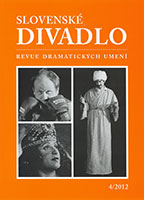Iná dráma rokov osemdesiatych
Another Drama from the 1980’s
Author(s): Andrej MaťašíkSubject(s): Theatre, Dance, Performing Arts
Published by: SAV - Slovenská akadémia vied - Ústav divadelnej a filmovej vedy SAV
Summary/Abstract: The author builds on his previous study and continues analyzing the early attempts to form alternative dramatics in the seventies of the twentieth century. He draws parallels between concentrated efforts of young theatre- makers to distinguish themselves from the conventional type of production dominating professional theatre scene at the time of normalization and attempts of the authors to break free from the mannerism of psychological realism, a form-creating base of so-called socialist realism in the field drama. In the eighties, the Theatre for Children and Youth in Trnava and A. Bagar Theatre in Nitra were the places of initiatives attempting to modernize the dramatic arts. In Trnava, B. Uhlár in collaboration with O. Šulaj as well as in his own texts emphasized the systemic critique of the social situation, using the means of grotesque, irony and sarcasm, which opened discussion within the theatre ensemble. Apparent contradiction to Uhlár‘s political theater were almost idyllic pastel and harmonious theatrical images by Juraj Nvota, created in collaboration with Miroslava Čibenková, Stanislav Štepka and other authors. A more detailed research, however, shows that Uhlár‘s expressive rebellion and Nvota‘s search for purity and beauty worked complementary and both mutually intensified the effect on the juvenile generation, which was the main recipients of theatre productions in Trnava. A team in Nitra, formed by the director Jozef Bednarik and the dramaturg Darina Kárová with the participation of visiting authors, (Vlado Bednár, Vincent Šikula, Andrej Ferko), was in more complex situation, because alongside the efforts of this group the theatre featured also original mainstream repertoire created in the conventional style of production. The second half of the eighties brought a retreat from more concentrated efforts to form a model of generational drama. This was related to movements within the theatre ensembles. In the Theatre for Children and Youth, but also in other art groups (amateur ensemble DISK, A. Duchnovič Theatre in Prešov) Blahoslav Uhlár continued steadily and even more progrssively his program, finally fully realized in the independent theatre STOKA in the nineties. Methods originally exclusively generated by young generation of theatre- makers were adopted by official authors. Conversely, authors who entered the theatre in the seventies and eighties as discontented rebels eventually accepted some of the conditions whose fulfillment limited the acceptance among the officially respected individualities – and their works subsequently became a part of the prestigious Slovak theatres and were aired on television.
Journal: Slovenské divadlo
- Issue Year: 60/2012
- Issue No: 04
- Page Range: 420-435
- Page Count: 15
- Language: Slovak

